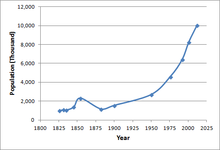Demographics of Bolivia

Scatter plot of the population of Bolivia (in thousands) from 1826–2012
|
|
| Population | 10,027,254 (2012) |
|---|---|
| Density | 9.1 people/km2 (2012) |
| Growth rate | 21.2% (2012) |
| Birth rate | 23.7 per 1,000 pop. (2013) |
| Death rate | 6.6 per 1,000 pop. (2013) |
| Life expectancy | 68.87 years (2014) |
| • male | 65.4 years (2013) |
| • female | 71.1 years (2013) |
| Fertility rate | 2.8 children born/woman (2013) |
| Infant mortality rate | 39.7 deaths/1,000 live births (2013) |
| 0–14 years | 31.0% (2012) |
| 15–64 years | 63.1% (2012) |
| 65 and over | 6.1% (2012) |
| Total | 0.99 male/female (2012) |
| Under 15 | 1.05 male/female (2012) |
| 15–64 years | 0.96 male/female (2012) |
| 65 and over | 0.88 male/female (2012) |
| Nationality | noun: Bolivian(s), adjective: Bolivian |
| Major ethnic | Quechua 45.6%, Ayamara 42.4% (2012) |
| Minor ethnic | 37 other ethnic groups (2012) |
| Official | Spanish, Quechua, Aymara, Guarani, and 34 other native languages |
The demographic characteristics of the population of Bolivia are known through censuses, with the first in 1826 and the most recent being in 2012. The National Institute of Statistics of Bolivia (INE) has performed this task since 1950. The population of Bolivia in 2012 had reached 10 million for the first time in history. The population density is 9.13 inhabitants per square kilometer, and the overall life expectancy in Bolivia at birth is 68.2 years. The population has steadily risen from the late 1800s to the present time. The natural growth rate of the population is positive, which has been a continuing trend since the 1950s; in 2012, Bolivia's birth rate continued to be higher than the death rate. Bolivia is in the third stage of demographic transition. In terms of age structure, the populations is dominated by the 15–64 segment. The median age of the population is 23.1, and the gender ratio of the total population is 0.99 males per female.
Bolivia is inhabited mostly by Quechua (45.6%) and Aymara (42.4%), while minorities include 37 indigenous groups (0.3% average per group). The Spanish, Quechua, Aymara, Guarani languages, as well as 34 other native languages are the official language of Bolivia. Spanish is the most-spoken language (60.7%) within the population. The main religions of Bolivia are Catholicism (81.8%), Evangelicalism (11.5%), and Protestantism (2.6%). Education is of poor quality, and has a 91.2% literacy rate. An estimated 7.6% of the country's gross domestic product (GDP) is spent on education. The average monthly household income was Bs.1,378 ($293) in 1994. In December 2013 the unemployment rate was 3.2% of the working population. Average urbanisation rate in Bolivia is 67%.
...
Wikipedia
